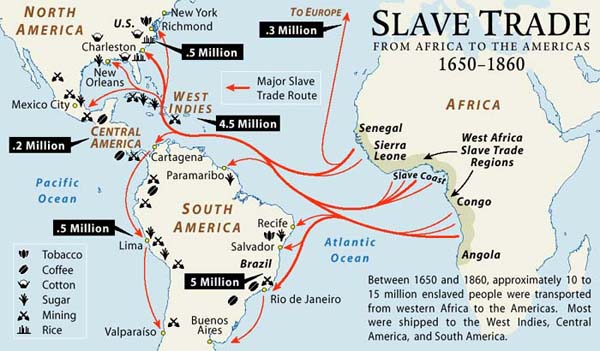"Pour Some Sugar on Me"
While Mexico and Peru were becoming great civilizations other colonies were still trying to catch up. "Brazil, ruled by Portugal, and in the Spanish, British, French, and Dutch colonies in the Caribbean"(Pg.567) had a different type of society. These colonies thrived off of sugar that their land produced. Many Europeans "found a very profitable substitute in sugar..where it was used as medicine, a spice, a sweetener, a preservative, and in sculptured forms as a decoration that indicated high status"(Pg.567).





Sugar changed Brazil and the Caribbeans, with that being said, the production of sugar "involved both growing the sugarcane and processing it into usable sugar, was very labor-intensive and could most profitably occur in a large-scale, almost industrial setting"(Pg.568). With the work being so hard it involved a large amount of workers which resulted in a "massive use of slave labor" (Pg.568). Slaves were traded from Africa and where "transported across the Atlantic, some 80 percent or more, ended up in Brazil and the Caribbean"(Pg.568).

The slaves who worked for the sugar plantations suffered extreme conditions. Death rates were "5 to 10 years per year, which required plantation owners to constantly import fresh slaves" (Pg.568). They had to suffer from extreme heat which many when seeing the production explained it like "scenes from Hell"(Pg.568).

Female and male slaves had the same roles, received the same amount of rations, and the same brutal punishments. Some women were hired to work inside homes and for white female owners. Other women who worked in "urban areas, mostly for white female owners, did domestic chores and were often hired out as laborers in various homes, shops, laundries, inns, and brothels"(Pg.568). Women were discouraged to have families and they preferred for them to remain alone. A women named Mary Prince stated "The great God above alone knows the thoughts of the poor slave's heart, and the bitter pains which follow such separations as these. All that we love taken away from us--oh, it is sad, sad! and sore to be borne!"(Pg.568).

With that being said, the population in Spanish America involved racial mixing. "Cross- racial unions accounted for only about 10% of all marriages in Brazil"(Pg.569). With that being said, Slavery was different in Latin America than North America. Latin Americans were imported where as North Americans allowed reproduction and were born in North America. In Brazil, slaves "were voluntarily set free by their owners..than in North America"(Pg. 570). Skin color in Brazil "was only one criterion of class status, and the perception of color changed with the educational or economic standing of individuals"(Pg.570).
The pictures you posted are so sad yet very real in which is very upsetting to understand how slavery was used. Its so disappointing in the human race not comprehending the moral and ethical values of all of us as human beings. Our differences are what make us unique but we are all people of this earth. Its just so crazy to think of how people of power abused and even thought of using slaves as the work force abusing them plus not treating them with any respect whatsoever. Even til this day, we all are looking for the true meaning of freedom, justice, and equality. Thank you for sharing this vivid post!
ReplyDelete